Effect of Cooling Blanket on the Heat Stress of Horses in Hot and Humid Environments
Abstract
:Simple Summary
Abstract
1. Introduction
2. Materials and Methods
2.1. Horses
2.2. Ice Horse Blankets
2.3. Experimental Design
2.4. Procedure
2.5. Physiological Measures
2.6. Cortisol Assays
2.7. Statistical Analysis
2.8. Weather Condition
3. Results
3.1. Physiological Measures
3.2. Plasma Cortisol
3.3. Correlation between Skin Surface Temperatures of the Three Sites of Horse’s Body (Front Back, Rear Back, Loin) and three Measurement Parameters (HR, RR and Plasma Cortisol)
4. Discussion
5. Conclusions
Author Contributions
Funding
Institutional Review Board Statement
Informed Consent Statement
Data Availability Statement
Acknowledgments
Conflicts of Interest
References
- Khasnis, A.A.; Nettleman, M.M. Global warming and infectious disease. Arch. Med. Res. 2005, 36, 689–696. [Google Scholar] [CrossRef] [PubMed]
- Hu, X.; Cai, M.; Yang, S.; Sejas, S.A. Air temperature feedback and its contribution to global warming. Sci. China Earth Sci. 2018, 61, 1491–1509. [Google Scholar] [CrossRef]
- Ministry of the Environment (MOE), Heat Stroke Protection Website. Available online: https://www.wbgt.env.go.jp/heatillness_pr.php (accessed on 14 March 2022).
- Park, D.S.; Gu, B.H.; Park, Y.J.; Joo, S.S.; Lee, S.S.; Kim, S.H.; Kim, E.T.; Kim, D.H.; Lee, S.S.; Lee, S.J.; et al. Dynamic changes in blood immune cell composition and function in Holstein and Jersey steers in response to heat stress. Cell Stress Chaperones 2021, 26, 705–720. [Google Scholar] [CrossRef] [PubMed]
- Chaiyabutr, N.; Chanpongsang, S.; Suadsong, S. Effects of evaporative cooling on the regulation of body water and milk production in crossbred Holstein cattle in a tropical environment. Int. J. Biometeorol. 2008, 52, 575–585. [Google Scholar] [CrossRef]
- Holcomb, K.E.; Tucker, C.B.; Stull, C.L. Shade use by small groups of domestic horses in a hot, sunny environment. J. Anim. Sci. 2015, 93, 5455–5464. [Google Scholar] [CrossRef]
- Janczarek, I.; Stachurska, A.; Wilk, I.; Wiśniewska, A.; Różańska-Boczula, M.; Kaczmarek, B.; Łuszczyński, J.; Kędzierski, W. Horse preferences for insolation, shade or mist curtain in the paddock under heat conditions: Cardiac and behavioural response analysis. Animals 2021, 11, 933. [Google Scholar] [CrossRef]
- Takahashi, Y.; Ohmura, H.; Mukai, K.; Shiose, T.; Takahashi, T. A comparison of 5 cooling methods in hot and humid environments in Thoroughbred horses. J. Equine Vet. Sci. 2020, 91, 103130. [Google Scholar] [CrossRef]
- Holcomb, K.E.; Tucker, C.B.; Stull, C.L. Physiological, behavioral, and serological responses of horses to shaded or unshaded pens in a hot, sunny environment. J. Anim. Sci. 2013, 91, 5926–5936. [Google Scholar] [CrossRef]
- Magrin, L.; Brscic, M.; Lora, I.; Rumor, C.; Tondello, L.; Cozzi, G.; Gottardo, F. Effect of a ceiling fan ventilation system on finishing young bulls’ health, behaviour and growth performance. Animal 2017, 11, 1084–1092. [Google Scholar] [CrossRef]
- Chanchai, W.; Chanpongsang, S.; Chaiyabutr, N. Effects of misty-fan cooling and supplemental rbST on rumen function and milk production of crossbred Holstein cattle during early, mid and late lactation in a tropical environment. Anim. Sci. J. 2009, 81, 230–239. [Google Scholar] [CrossRef]
- Tresoldi, G.; Schütz, K.E.; Tucker, C.B. Cooling cows with sprinklers: Effects of soaker flow rate and timing on behavioral and physiological responses to heat load and production. J. Dairy Sci. 2019, 102, 528–538. [Google Scholar] [CrossRef] [PubMed]
- Chen, J.M.; Schütz, K.E.; Tucker, C.B. Sprinkler flow rate affects dairy cattle avoidance of spray to the head, but not overall, in an aversion race. Appl. Anim. Behav. Sci. 2016, 179, 23–31. [Google Scholar] [CrossRef]
- He, Y.; Chen, W.; Wang, Z.; Zhanga, H. Review of fan-use rates in field studies and their effects on thermal comfort, energy conservation, and human productivity. Energy Build. 2019, 194, 140–162. [Google Scholar] [CrossRef]
- Tahara, Y.; Morito, N.; Nishimiya, H.; Yamagishi, H.; Yamaguchi, M. Evaluation of environmental and physiological factors of a whole ceiling-type air conditioner using a salivary biomarker. Build Environ. 2009, 44, 1156–1161. [Google Scholar] [CrossRef]
- Janczarek, I.; Wiśniewska, A.; Tkaczyk, E.; Wnuk-Pawlak, E.; Kaczmarek, B.; Liss-Szczepanek, M.; Kędzierski, W. Effect of Different Water Cooling Treatments on Changes in Rectal and Surface Body Temperature in Leisure Horses after Medium-Intensity Effort. Animals 2022, 12, 525. [Google Scholar] [CrossRef]
- Kuwano, A.; Yoshihara, T.; Takatori, K.; Kosuge, J. Onychomycosis in white line disease in horses: Pathology, mycology and clinical features. Equine Vet J. 1998, 26, 27–35. [Google Scholar] [CrossRef]
- Petrov, K.; Dicks, M.T. Fusobacterium necrophorum, and not Dichelobacter nodosus, is associated with equine hoof thrush. Vet. Microbiol. 2013, 161, 350–352. [Google Scholar] [CrossRef]
- McGill, S.; Coleman, B.; Hayes, M. Air Speed to Increase Rate of Cool Out for Horses After Intense Exercise. J. Equine Vet. Sci. 2021, 102, 103641. [Google Scholar] [CrossRef]
- Zare, M.; Dehghan, H.; Vazdanirad, S.; Khoshakhlagh, A.H. Comparison of the impact of an optimized ice cooling vest and a paraffin cooling vest on physiological and perceptual strain. Saf. Health Work 2019, 10, 219–223. [Google Scholar] [CrossRef]
- Luomala, M.J.; Oksa, J.; Salmi, J.A.; Linnamo, V.; Holmér, I.; Smolander, J.; Dugué, B. Adding a cooling vest during cycling improves performance in warm and humid conditions. J. Therm. Biol. 2012, 37, 47–55. [Google Scholar] [CrossRef]
- Hasegawa, H.; Takatori, T.; Komura, T.; Yamasaki, M. Wearing a cooling jacket during exercise reduces thermal strain and improves endurance exercise performance in a warm environment. J. Strength Cond. Res. 2005, 19, 122–128. [Google Scholar] [CrossRef] [PubMed]
- Collier, R.J.; Gebremedhin, K.G. Thermal biology of domestic animals. Annu. Rev. Anim. Biosci. 2015, 3, 513–532. [Google Scholar] [CrossRef] [PubMed]
- Bilgili, M.; Simsek, E.; Sahin, B.; Yasar, A.; Ozbek, A. Estimation of human heat loss in five Mediterranean regions. Physiol. Behav. 2015, 149, 61–68. [Google Scholar] [CrossRef] [PubMed]
- World Organisation for Animal Health (OIE), Animal Welfare at WOAH. Available online: https://www.woah.org/en/what-we-do/animal-health-and-welfare/animal-welfare (accessed on 14 March 2022).
- Wilk, I.; Wnuk-Pawlak, E.; Janczarek, I.; Kaczmarek, B.; Dybczyńska, M.; Przetacznik, M. Distribution of superficial body temperature in horses ridden by two riders with varied body weights. Animals 2020, 10, 340. [Google Scholar] [CrossRef]
- Westermann, S.; Stanek, C.; Schramel, J.P.; Ion, A.; Buchner, H.H.F. The effect of airflow on thermographically determined temperature of the distal forelimb of the horse. Equine Vet. J. 2013, 45, 637–641. [Google Scholar] [CrossRef]
- Schütz, K.E.; Rogers, A.R.; Poulouin, Y.A.; Cox, N.R.; Tucker, C.B. The amount of shade influences the behavior and physiology of dairy cattle. J. Dairy Sci. 2010, 93, 125–133. [Google Scholar] [CrossRef]
- Morgan, K. Thermoneutral zone and critical temperatures. J. Therm. Biol. 1998, 23, 59–61. [Google Scholar] [CrossRef]
- Lallo, C.H.O.; Cohen, J.; Rankine, D.; Taylor, M.; Cambell, J.; Stephenson, T. Characterizing heat stress on livestock using the temperature humidity index (THI)—Prospects for a warmer Caribbean. Reg. Environ. Change 2018, 18, 2329–2340. [Google Scholar] [CrossRef]
- St-Pierre, N.R.; Cobanov, B.; Schnitkey, G. Economic losses from heat stress by US livestock industries. J. Dairy Sci. 2003, 86, 52–77. [Google Scholar] [CrossRef]
- Japan Weather Association (JWA), Index Information Table. Available online: https://tenki.jp/indexes (accessed on 14 March 2022).
- Rammerstorfer, C.; Potter, G.D.; Brumbaugh, G.W.; Gibbs, P.G.; Varner, D.D.; Rammerstorfer, E.H. Physiologic responses of acclimatized or non-acclimatized mature reining horses to heat stress: I. heart rate, respiration rate, lactate, rectal temperature, cortisol and packed cell volume. J. Equine Vet. Sci. 2001, 21, 431–438. [Google Scholar] [CrossRef]
- Mueller, I.; Snidman, N.; DiCorcia, J.A.; Tronick, E. Acute maternal stress disrupts infant regulation of the autonomic nervous system and behavior: A casp study. Front. Psychiatry 2021, 12, 716664. [Google Scholar] [CrossRef]
- Won, E.; Kim, Y.K. Stress, the autonomic nervous system, and the immune-kynurenine pathway in the etiology of depression. Curr. Neuropharmacol. 2016, 14, 665–673. [Google Scholar] [CrossRef]
- Appelhans, B.M.; Pagoto, S.L.; Peters, E.N.; Spring, B.J. HPA axis response to stress predicts short-term snack intake in obese women. Appetite 2010, 54, 217–220. [Google Scholar] [CrossRef] [PubMed]
- Stull, C.L.; Morrow, J.; Aldridge, B.A.; Stott, J.L.; McGlone, J.J. Immunophysiological responses of horses to a 12-hour rest during 24 hours of road transport. Vet. Record. 2008, 162, 609–614. [Google Scholar] [CrossRef] [PubMed]
- Melchert, M.; Nagel, C.; Aurich, C.; Aurich, J. Transport-related stress in five-day-old foals and their dams. J. Vet. Behav. 2020, 39, 86–89. [Google Scholar] [CrossRef]
- Suagee-Bedore, J.K.; Linden, D.R.; Bennett-Wimbush, K. Effect of pen size on stress responses of stall-housed horses receiving one hour of daily turnout. J. Equine Vet. Sci. 2021, 98, 103366. [Google Scholar] [CrossRef]
- Bohák, Z.; Szabó, F.; Beckers, J.F.; Melo de Sousa, N.; Kutasi, O.; Nagya, K.; Szenci, O. Monitoring the circadian rhythm of serum and salivary cortisol concentrations in the horse. Domest. Anim. Endocrinol. 2013, 45, 38–42. [Google Scholar] [CrossRef]
- Wang, F.; Song, W. An investigation of thermophysiological responses of human while using four personal cooling strategies during heatwaves. J. Therm. Biol. 2017, 70, 37–44. [Google Scholar] [CrossRef]
- Wang, F.; Ke, Y.; Udayraj; Yang, B.; Xu, P.; Noor, N. Effect of cooling strategies on overall performance of a hybrid personal cooling system incorporated with phase change materials (PCMs) and electric fans. J. Therm. Biol. 2022, 92, 102655. [Google Scholar] [CrossRef]
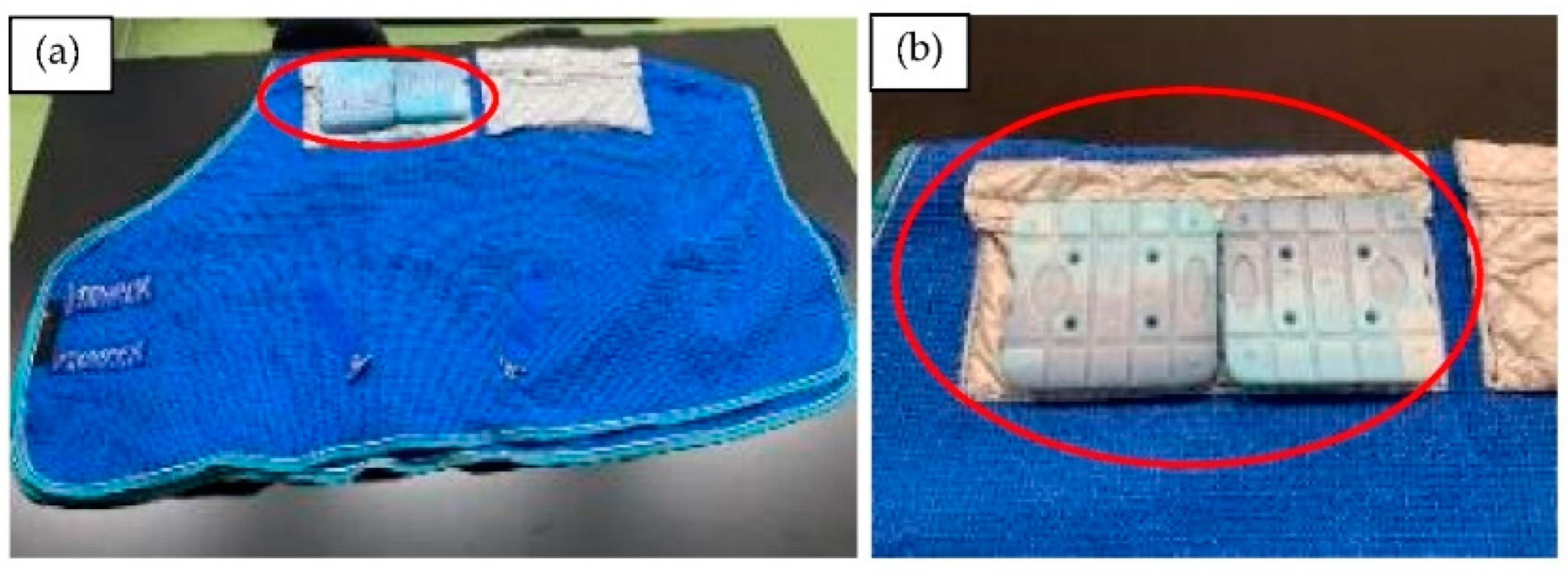
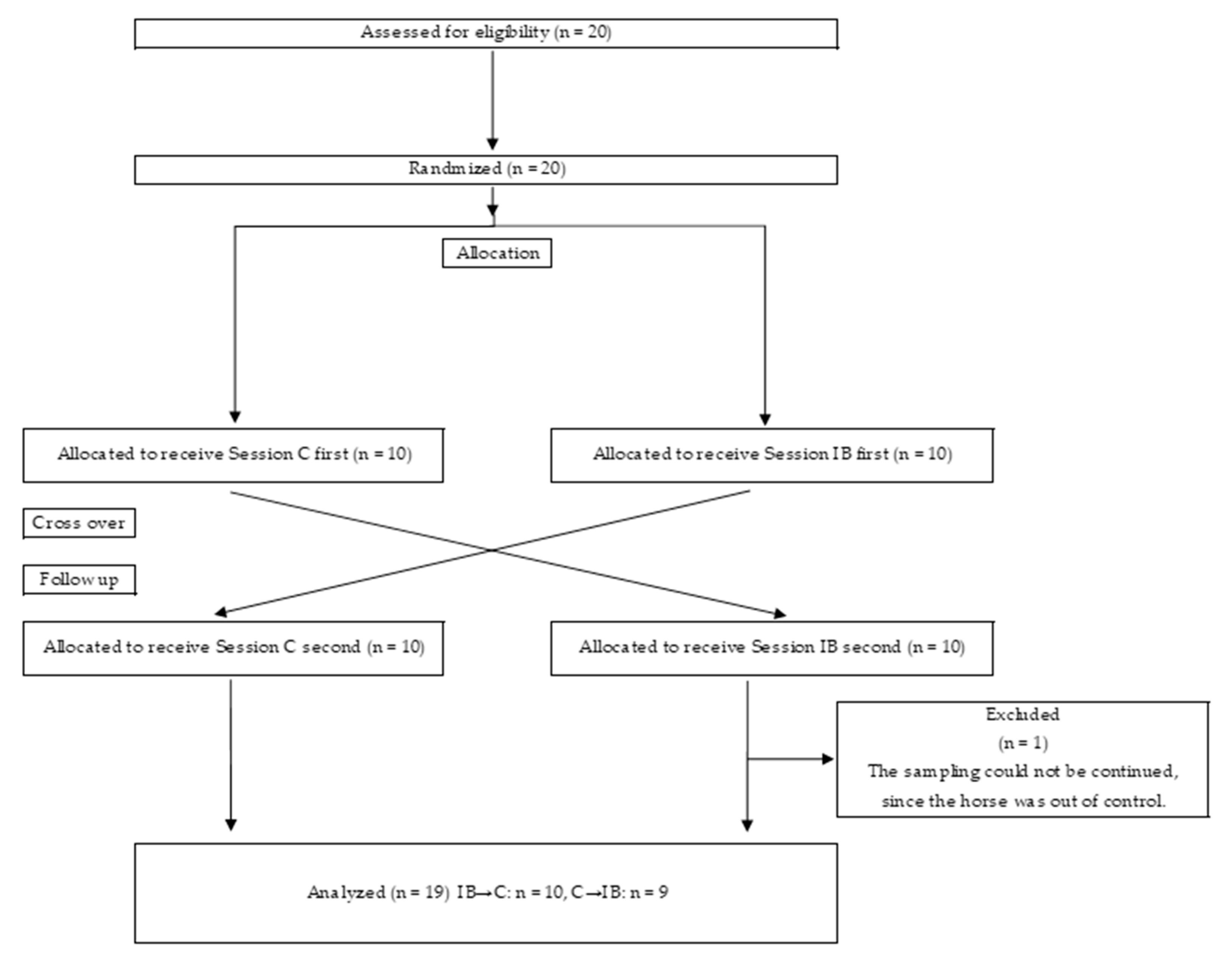
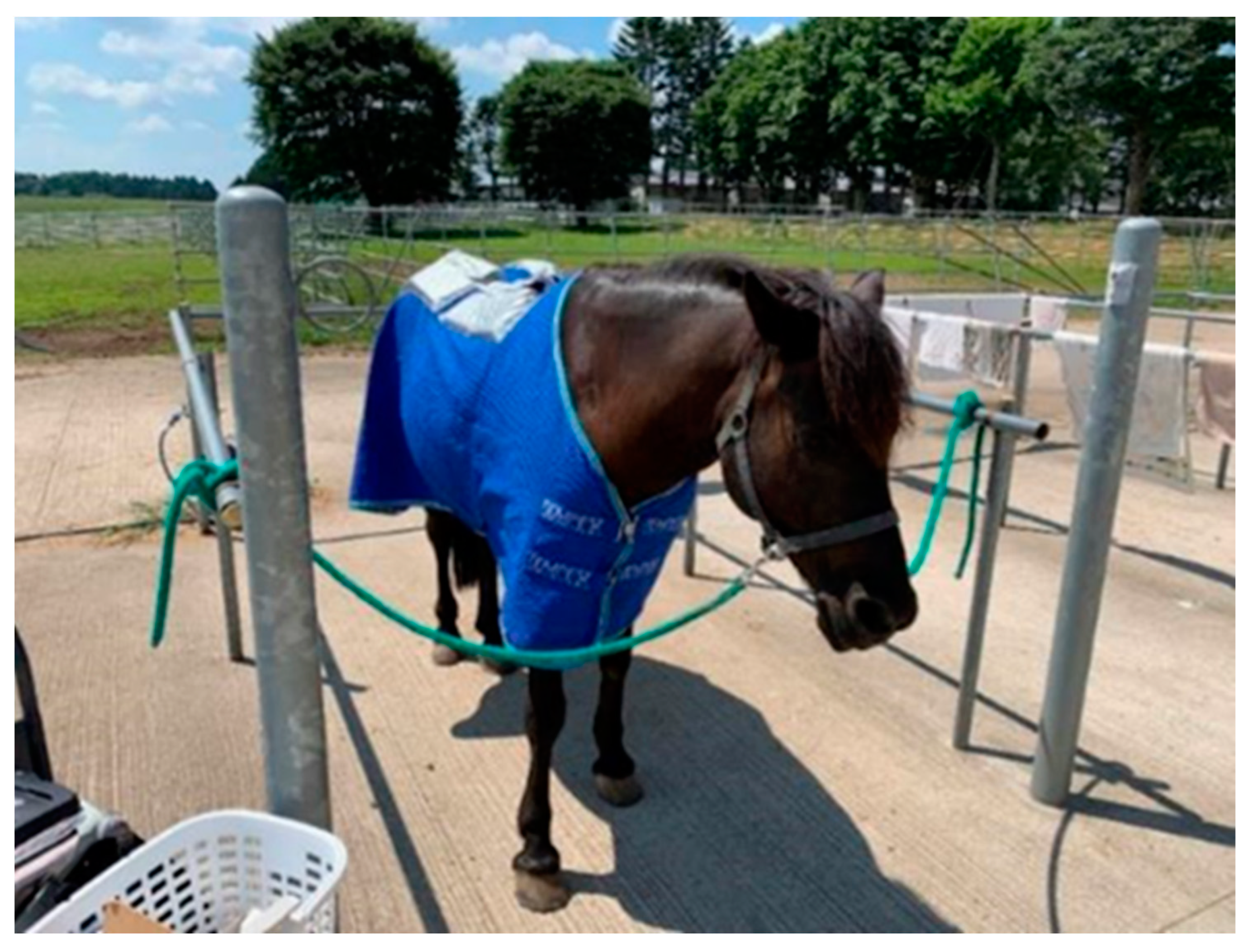
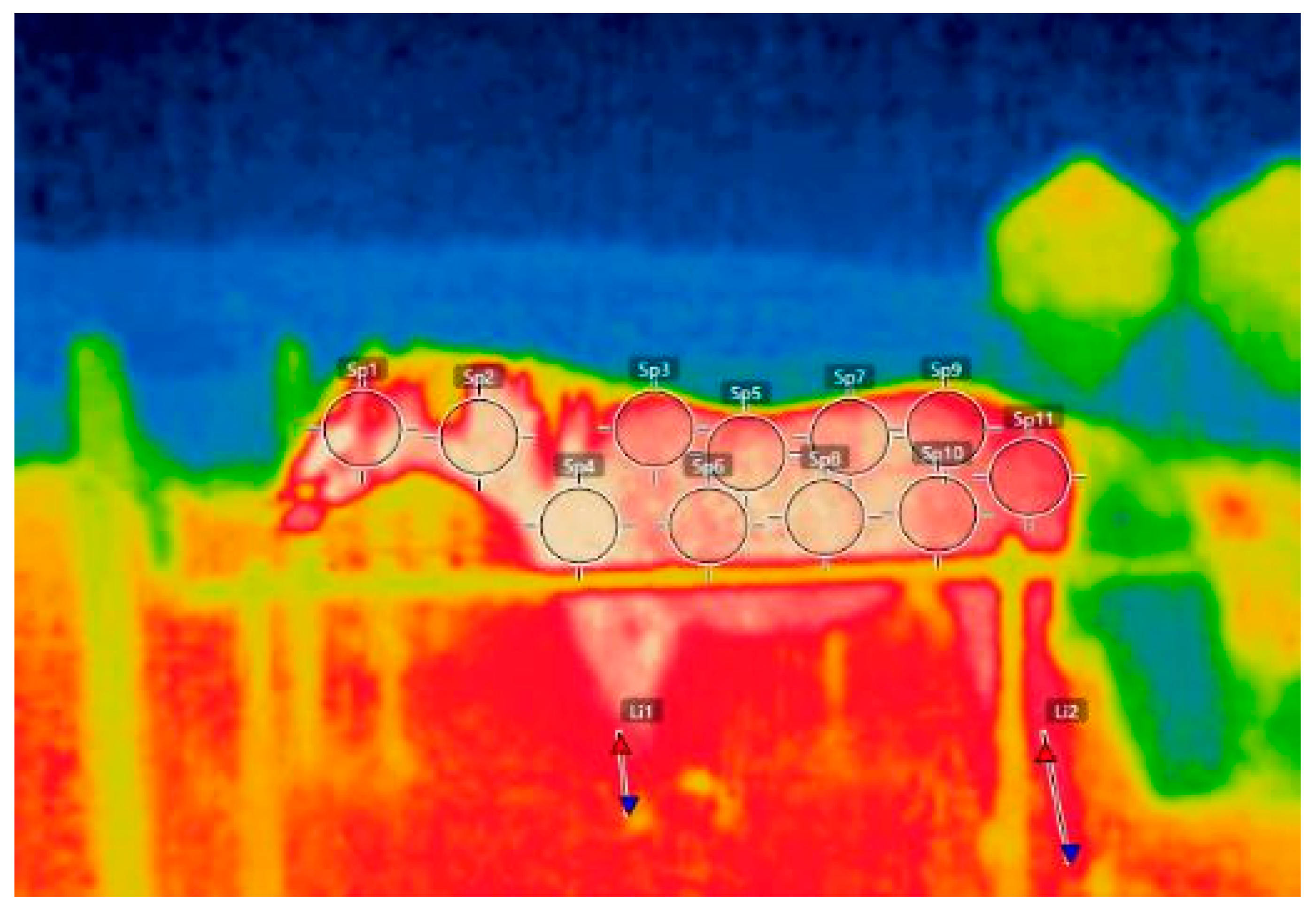
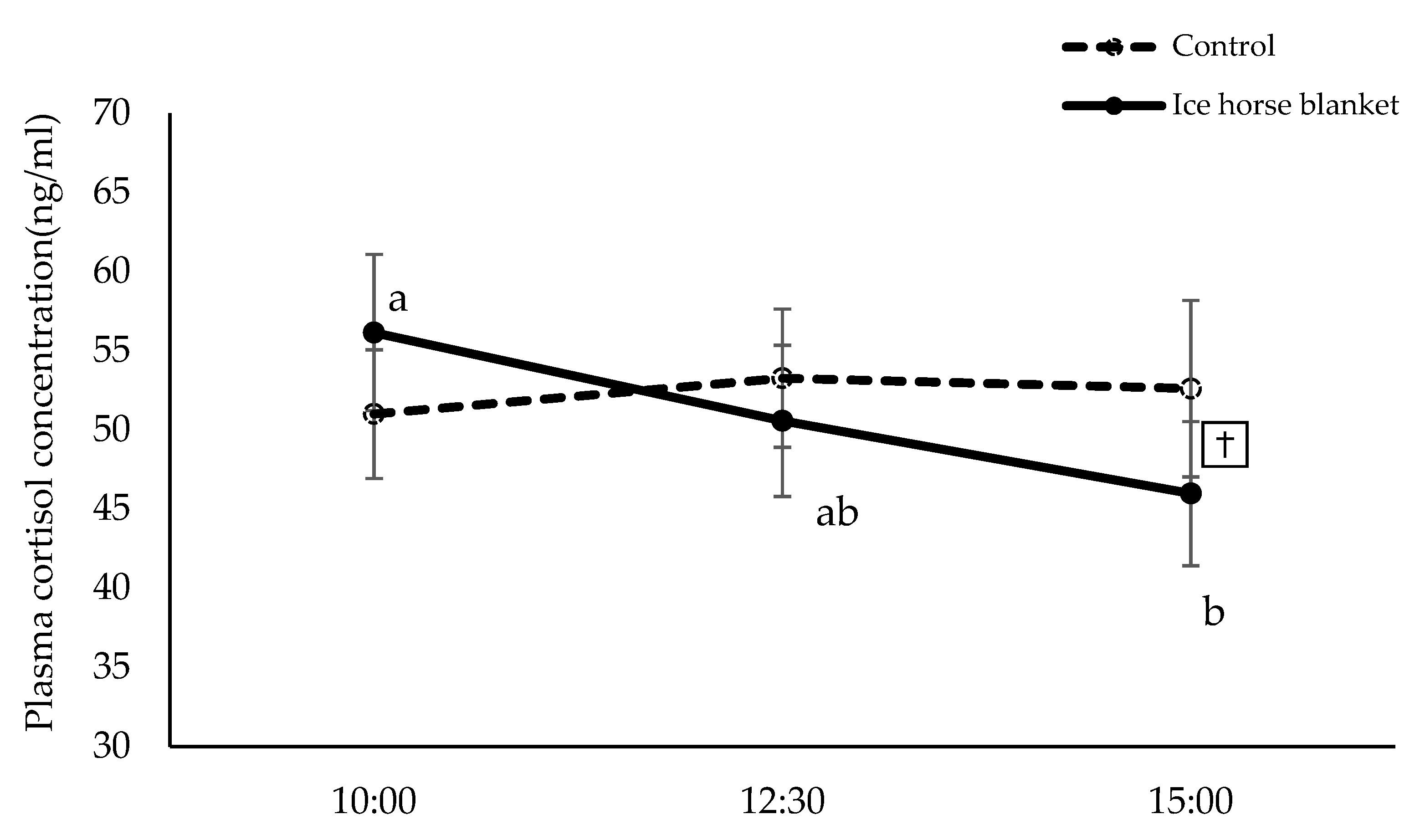
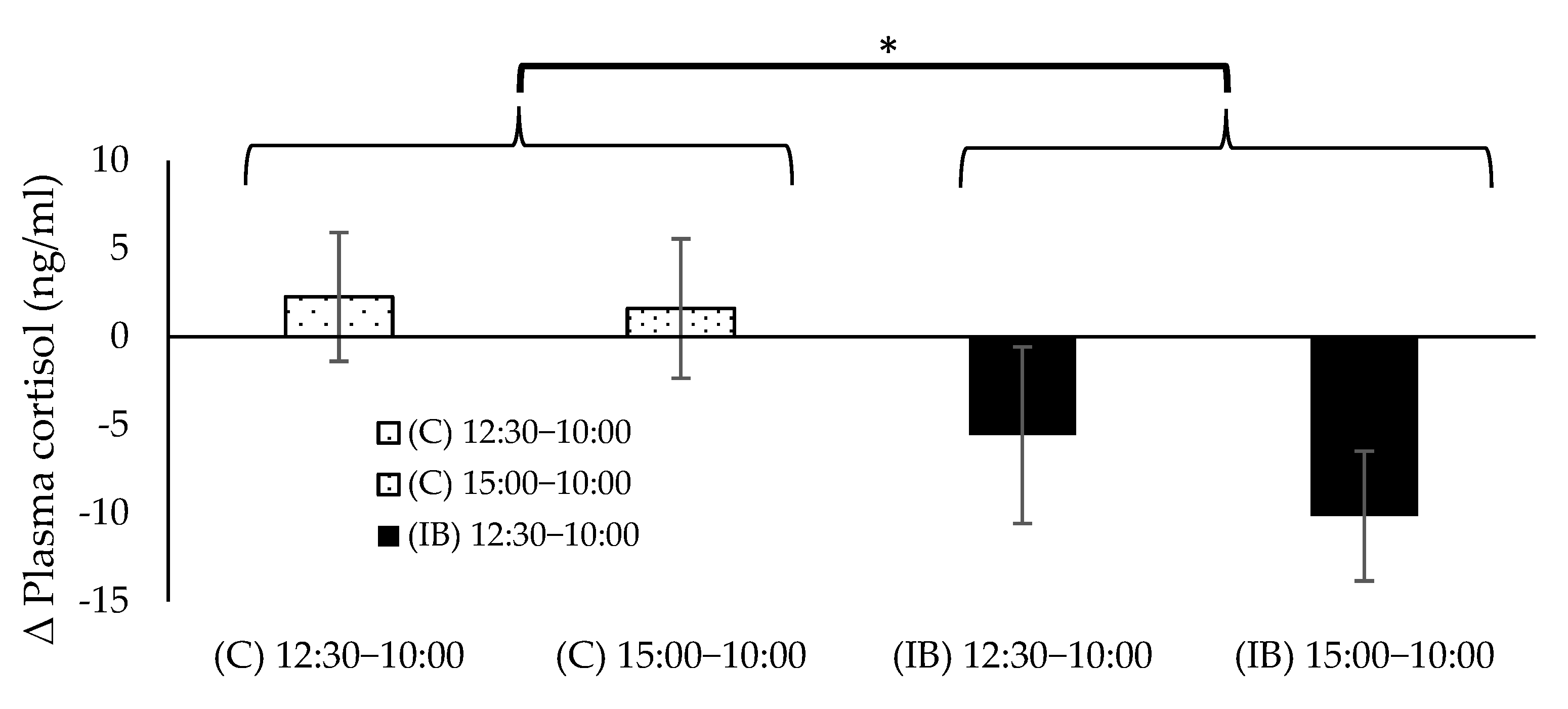
| Weather Condition | Mean ± SE, (n = 19) | |||||
|---|---|---|---|---|---|---|
| (C)10:00 | (C)12:30 | (C)15:00 | (IB)10:00 | (IB)12:30 | (IB)15:00 | |
| Tamb (°C) | 26.5 ± 0.4 a | 27.9 ± 0.5 b | 27.4 ± 0.5 ab | 26.2 ± 0.5 a | 27.6 ± 0.6 b | 27.1 ± 0.6 ab |
| RH (%) | 71.0 ± 1.8 a | 67.2 ± 1.7 b | 69.2 ± 1.6 ab | 70.9 ± 2.0 a | 67.6 ± 1.9 b | 69.4 ± 1.9 ab |
| THI | 75.7 ± 0.6 a | 77.8 ± 0.7 b | 77.3 ± 0.7 b | 75.5 ± 0.6 a | 77.3 ± 0.8 b | 76.9 ± 0.9 b |
| Weather Condition | Statistics | ||
|---|---|---|---|
| Treatment × Time | ME in Time | ME in Treatment | |
| Tamb (°C) | NS | p < 0.05 | NS |
| RH (%) | NS | p < 0.05 | NS |
| THI | NS | p < 0.05 | NS |
| Skin Surface Temperature (°C) | Mean ± SE, (n = 19) | |||||
|---|---|---|---|---|---|---|
| (C)10:00 | (C)12:30 | (C)15:00 | (IB)10:00 | (IB)12:30 | (IB)15:00 | |
| Head | 31.6 ± 0.5 | 32.0 ± 0.8 | 31.7 ± 0.7 | 31.7 ± 0.8 | 32.0 ± 0.7 | 32.0 ± 0.7 |
| Neck | 32.0 ± 0.5 | 32.7 ± 0.7 | 31.6 ± 0.6 | 31.6 ± 0.8 | 32.1 ± 0.6 | 31.8 ± 0.7 |
| Withers | 33.3 ± 0.6 | 33.4 ± 0.8 | 33.0 ± 0.7 | 33.0 ± 0.6 | 32.4 ± 0.6 | 32.3 ± 0.6 |
| Shoulder | 33.0 ± 0.5 | 33.1 ± 0.6 | 32.8 ± 0.6 | 32.7 ± 0.6 | 32.3 ± 0.5 | 32.2 ± 0.5 |
| Front back | 32.9 ± 0.6 | 33.8 ± 0.8 | 33.2 ± 0.8 | 32.7 ± 0.6a | 31.5 ± 0.5 *ab | 30.9 ± 0.6 *b |
| Front abdomen | 32.9 ± 0.5 | 33.0 ± 0.6 | 32.5 ± 0.6 | 32.8 ± 0.6 | 32.2 ± 0.7 | 32.3 ± 0.6 |
| Rear back | 33.0 ± 0.6 | 33.7 ± 0.9 | 33.2 ± 0.8 | 32.5 ± 0.6 | 31.5 ± 0.5 * | 31.1 ± 0.5 * |
| Rear abdomen | 32.5 ± 0.6 | 33.2 ± 0.6 | 32.8 ± 0.7 | 32.8 ± 0.6 | 32.6 ± 0.4 | 32.3 ± 0.5 |
| Loin | 32.5 ± 0.5 | 33.7 ± 0.8 | 33.3 ± 0.9 | 32.3 ± 0.6 | 31.6 ± 0.6 * | 31.2 ± 0.5 * |
| Thigh | 32.3 ± 0.5 | 32.7 ± 0.7 | 32.3 ± 0.7 | 32.2 ± 0.6 | 32.2 ± 0.4 | 32.1 ± 0.5 |
| Buttock | 32.2 ± 0.5 | 32.9 ± 0.8 | 32.4 ± 0.8 | 32.3 ± 0.7 | 32.2 ± 0.5 | 32.1 ± 0.5 |
| Fore-cannon | 31.8 ± 0.8 a | 34.7 ± 1.1 b | 33.5 ± 1.2 ab | 31.8 ± 1.0 a | 33.9 ± 0.9 b | 33.0 ± 1.0 ab |
| Rear-cannon | 32.3 ± 0.9 a | 35.0 ± 1.1 b | 33.9 ± 1.2 ab | 31.9 ± 1.1 a | 34.4 ± 0.8 b | 33.2 ± 0.9 ab |
| Skin Surface Temperature (°C) | Statistics | ||
|---|---|---|---|
| Treatment × Time | ME in Time | ME in Treatment | |
| Head | NS | NS | NS |
| Neck | NS | NS | NS |
| Withers | NS | NS | NS |
| Shoulder blade | NS | NS | NS |
| Front back | p < 0.05 | - | - |
| Front abdomen | NS | NS | NS |
| Rear back | p < 0.1 | - | - |
| Rear abdomen | NS | NS | NS |
| Loin | p < 0.05 | - | - |
| Thigh | NS | NS | NS |
| Buttock | NS | NS | NS |
| Fore-cannon | NS | p < 0.05 | NS |
| Rear-cannon | NS | p < 0.05 | NS |
| Skin surface Temperature (°C) | Statistics | ||||
|---|---|---|---|---|---|
| (10:00) SME in Treatment | (12:30) SME in Treatment | (15:00) SME in Treatment | (C) SME in Time | (IB) SME in Time | |
| Head | - | - | - | - | - |
| Neck | - | - | - | - | - |
| Withers | - | - | - | - | - |
| Shoulder blade | - | - | - | - | - |
| Front back | NS | p < 0.05 | p < 0.05 | NS | p < 0.05 |
| Front abdomen | - | - | - | - | - |
| Rear back | NS | p < 0.05 | p < 0.05 | NS | p < 0.1 |
| Rear abdomen | - | - | - | - | - |
| Loin | NS | p < 0.05 | p < 0.05 | NS | NS |
| Thigh | - | - | - | - | - |
| Buttock | - | - | - | - | - |
| Fore-cannon | - | - | - | - | - |
| Rear-cannon | - | - | - | - | - |
| Physiological Measures | Mean ± SE, (n = 19) | |||||
|---|---|---|---|---|---|---|
| (C)10:00 | (C)12:30 | (C)15:00 | (IB)10:00 | (IB)12:30 | (IB)15:00 | |
| HR (bpm) | 36.6 ± 0.9 | 36.6 ± 1.2 | 36.0 ± 1.0 | 38.1 ± 1.1 a | 33.9 ± 0.5 *b | 32.9 ± 0.7 *b |
| RR (bpm) | 32.4 ± 1.7 | 30.6 ± 1.5 | 30.0 ± 1.1 | 33.3 ± 2.5 a | 23.1 ± 1.4 *b | 21.6 ± 1.5 *b |
| RT (°C) | 37.32 ± 0.05 a | 37.23 ± 0.04 ab | 37.20 ± 0.04 b | 37.36 ± 0.05 * | 37.38 ± 0.04 * | 37.32 ± 0.04 * |
| Physiological Measures | Statistics | ||
|---|---|---|---|
| Treatment × Time | ME in Time | ME in Treatment | |
| HR (bpm) | p < 0.05 | - | - |
| RR (bpm) | p < 0.05 | - | - |
| RT (°C) | NS | p < 0.1 | p < 0.05 |
| Physiological Measures | Statistics | ||||
|---|---|---|---|---|---|
| (10:00) SME in Treatment | (12:30) SME in Treatment | (15:00) SME in Treatment | (C) SME in Time | (IB) SME in Time | |
| HR (bpm) | NS | p < 0.05 | p < 0.05 | NS | p < 0.05 |
| RR (bpm) | NS | p < 0.05 | p < 0.05 | NS | p < 0.05 |
| RT (°C) | - | - | - | - | - |
| Measures | Front Back and HR | Rear Back and HR | Loin and HR | ||||||
| Both | C | IB | Both | C | IB | Both | C | IB | |
| Correlation | 0.237 | 0.0550 | 0.390 | 0.232 | 0.0470 | 0.396 | 0.235 | 0.0830 | 0.365 |
| p-value | 0.011 | NS | 0.0030 | 0.013 | NS | 0.0020 | 0.012 | NS | 0.0050 |
| Measures | Front back and RR | Rear back and RR | Loin and RR | ||||||
| Both | C | IB | Both | C | IB | Both | C | IB | |
| Correlation | 0.317 | 0.135 | 0.386 | 0.295 | 0.344 | 0.344 | 0.257 | 0.177 | 0.298 |
| p-value | 0.0010 | NS | 0.0030 | 0.0010 | NS | 0.0090 | 0.0060 | NS | 0.025 |
| Measures | Front back and cortisol | Rear back and cortisol | Loin and cortisol | ||||||
| Both | C | IB | Both | C | IB | Both | C | IB | |
| Correlation | 0.271 | 0.211 | 0.355 | 0.213 | 0.157 | 0.288 | 0.213 | 0.160 | 0.281 |
| p-value | 0.0040 | NS | 0.0070 | 0.023 | NS | 0.030 | 0.023 | NS | 0.034 |
Publisher’s Note: MDPI stays neutral with regard to jurisdictional claims in published maps and institutional affiliations. |
© 2022 by the authors. Licensee MDPI, Basel, Switzerland. This article is an open access article distributed under the terms and conditions of the Creative Commons Attribution (CC BY) license (https://creativecommons.org/licenses/by/4.0/).
Share and Cite
Ojima, Y.; Torii, S.; Maeda, Y.; Matsuura, A. Effect of Cooling Blanket on the Heat Stress of Horses in Hot and Humid Environments. Animals 2022, 12, 2505. https://doi.org/10.3390/ani12192505
Ojima Y, Torii S, Maeda Y, Matsuura A. Effect of Cooling Blanket on the Heat Stress of Horses in Hot and Humid Environments. Animals. 2022; 12(19):2505. https://doi.org/10.3390/ani12192505
Chicago/Turabian StyleOjima, Yuki, Suzuka Torii, Yosuke Maeda, and Akihiro Matsuura. 2022. "Effect of Cooling Blanket on the Heat Stress of Horses in Hot and Humid Environments" Animals 12, no. 19: 2505. https://doi.org/10.3390/ani12192505
APA StyleOjima, Y., Torii, S., Maeda, Y., & Matsuura, A. (2022). Effect of Cooling Blanket on the Heat Stress of Horses in Hot and Humid Environments. Animals, 12(19), 2505. https://doi.org/10.3390/ani12192505






